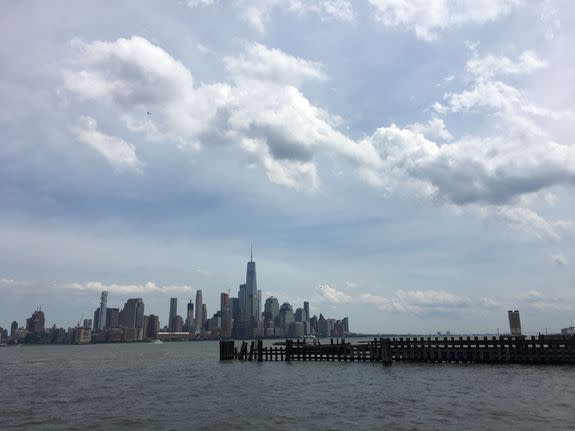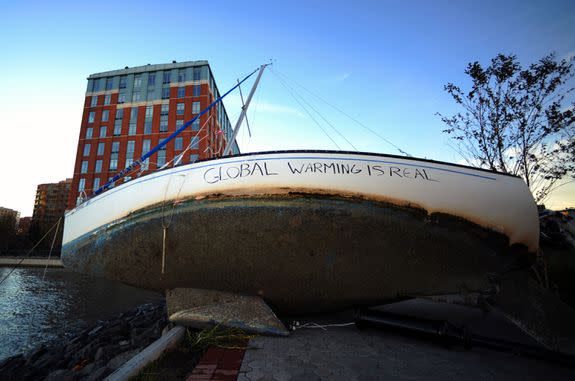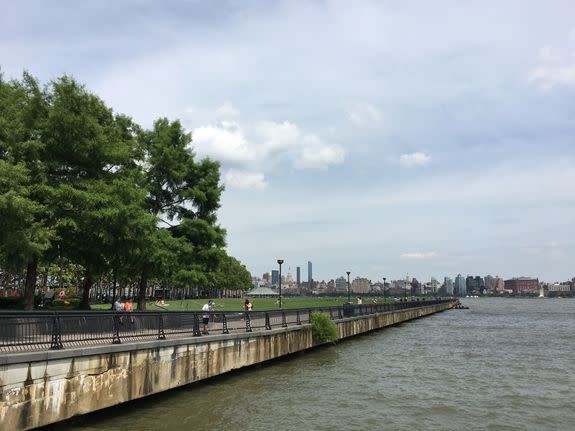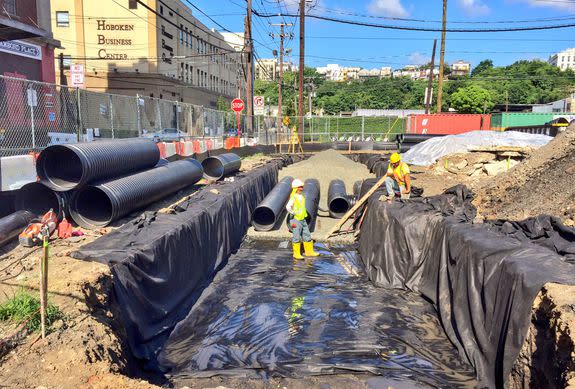This mayor is leaving politics to fight climate change full-time

Like many communities skirting the U.S. coastline, Hoboken, New Jersey, wasn’t built on solid ground.
Many of its charming brick buildings, historic piers, and apartment towers stand atop what was once a low-lying tidal marsh — a grassy, muddy buffer along the Hudson River, designed by nature to absorb high tides and storm surge like a sponge.
Early developers drained the marshlands in the 1800s to make way for modern Hoboken: the birthplace of singer Frank Sinatra, the location of TLC’s Cake Boss, and home to 53,000 people packed within the 1.25-square-mile city limit. Across the river, Manhattan’s glassy skyscrapers sparkle in the summer sunlight.
SEE ALSO: U.S. mayors and governors defy Trump, will stick to Paris agreement anyway
But Hoboken has never forgotten its marshy roots. Heavy rain events and storms routinely cause serious flooding here, only now the water buries streets, clogs sewers, damages homes, and fills train stations. Going forward, this problem will likely get much worse due to sea level rise, which allows water to more readily pour into Hoboken’s bathtub-shaped topography.

Image: Maria gallucci/mashable
“We are a city that’s on the frontlines of climate change,” Hoboken Mayor Dawn Zimmer said by phone one sweltering July afternoon. She spoke from City Hall, an imposing white-and-brown building just blocks from the waterfront.
This reality became painfully clear for Hoboken when, on Oct. 29, 2012, Hurricane Sandy’s storm surge put around 80 percent of the city underwater, leaving most residents without power for weeks. Sandy caused more than $100 million in private property damages in this small community, while in neighboring New York City, 48 people lost their lives.

Image: Peter Foley/Epa/REX/Shutterstock
Hoboken’s flooding problems have been a central theme during Zimmer’s eight years as mayor. She’s routinely battled with inundated streets and buildings, grappled with the aftermath of Sandy, and occasionally sparred with residents over how to best defend Hoboken from the encroaching effects of human-caused global warming.
Zimmer has also led efforts to begin transforming Hoboken into a more resilient city, one that can soak up stormwater with rain gardens and porous pavement, or hold back deluges with underground chambers and floodgates. She’s pushed to lift electrical substations and emergency vehicles out of harm’s way and to expand sewage systems overwhelmed by ever more stormwater.
The ability to take local climate action is what motivated Zimmer to run for mayor in 2009. Now, it’s guiding her next steps.

Image: Mel Evans/AP/REX/Shutterstock
In June, she announced she won’t seek re-election in November. Instead, she’ll focus full-time on helping other cities fight climate change, though she doesn’t know how or where just yet. She said the Trump administration’s sweeping rollback of federal climate policy is a big reason she’s going all-in on climate.
“Right now, when we lack leadership at the federal level, it’s all the more important that action is being taken on the local level,” the 49-year-old mayor said. “I feel like my calling is to go out and do as much as I can on that front: helping other communities be as resilient and sustainable as possible going forward.”
Henk Ovink, a Dutch water-management expert who worked closely with Zimmer on post-Sandy rebuilding efforts, said Zimmer is a “dynamic force” in this arena. The two first met in Hoboken in 2013, shortly before Ovink became an advisor to then President Barack Obama’s Hurricane Sandy Task Force.

Image: Maria gallucci/mashable
Right away, “she started to talk about the challenges and opportunities to rebuild the city in a way that it would actually be able to deal with that future uncertainty,” Ovink recalled by phone from the Netherlands, where he’s now the nation’s special envoy for international water affairs.
“I hope she’s going to step out and be an active voice and partner in our global efforts to deal with these challenges,” he said.
Local leaders rise up
Zimmer is far from alone in wanting to inspire local climate action as the Trump administration heads in the opposite direction. In recent months, thousands of local officials have vowed to fill the vacuum of climate leadership.
President Donald Trump and his top cabinet officials, who have repeatedly denied the scientific evidence on climate change, have begun unraveling policies to reduce carbon emissions from power plants, limit oil and gas production in sensitive areas, and curb water pollution from coal mining. Officials have proposed drastic cuts in funding and staffing at multiple climate science agencies.

Image: City of Hoboken
Yet for local officials, Trump’s most alarming move came on June 1, when the president said he would withdraw the United States from the Paris Climate Agreement, an international accord to limit global warming. The move puts the U.S. at odds with almost the entire world and threatens to delay climate action both at home and abroad.
In response, U.S. governors, mayors, investors, universities, and companies have banded together, pledging to uphold America’s commitments to the Paris agreement by continually reducing their own emissions. A bipartisan group of hundreds of mayors separately called for cities to adopt 100 percent renewable energy by 2035.

Image: city of hoboken
“It’s all happening because the science and the discussions we’re having are revealing the very important nature of being proactive on this now,” said Jackie Biskupski, mayor of Salt Lake City, who helped coordinate the renewables pledge. Utah, she noted, has warmed twice as fast as the global average over the last 40 years, straining Salt Lake City’s limited water supplies.
For Zimmer, a Democrat, Trump’s climate pushback is all the more reason to focus on climate resiliency.
“I just feel like the clock is ticking on this issue,” she said. “The risk is so dramatic.”
The clock is ticking

Image: bob al-greene/mashable
Zimmer didn’t plan to enter city politics when she moved with her family to Hoboken from Manhattan in 2002.
Initially, she worked as a photographer and stayed home to raise her two young sons. But soon she became involved in Hoboken civic life, advocating for more park space. She joined a pro-parks committee in 2006, and a year later, she was elected to Hoboken City Council.
Then in 2009, Zimmer picked up a copy of Thomas Friedman’s book Hot, Flat, and Crowded, which calls for a U.S.-led “green revolution” that will “renew America.” As Zimmer read in bed one night, she came across a passage describing how local politicians can take meaningful action to address climate change.

Image: City of Hoboken
Inspiration struck: She could lead Hoboken’s climate efforts as mayor. At 2 a.m, she woke up her husband, Stan Grossbard, and said, “‘I have to run,’” she said. “I didn’t know whether I could win, but I knew that I had to try.”
Zimmer lost the 2009 election by 161 votes in a runoff to Peter Cammarano III. But, in a TV-worthy twist, Cammarano resigned a few weeks after being sworn in. He’d been caught accepting $25,000 in bribe money from an FBI cooperating witness, who posed as a developer in a sweeping corruption sting.
Zimmer, who was City Council president, became acting mayor and later won in a special election, making her Hoboken’s first woman mayor since its founding in 1849. She was elected to a second four-year term in 2013.
Since then, Zimmer has launched a number of projects to make Hoboken more resilient, though given the scale of the city’s future flood risks, these are really just first steps toward safeguarding the city.
The city has steadily acquired nine acres to build “resiliency parks,” which will combine public amenities such as playgrounds, walkways, and dog runs with “green infrastructure” — rain gardens, shade tree pits, porous pavement, and underground detention systems that soak up stormwater and cool down sunbaked streets. A planned 5-acre park could hold up to 1 million gallons when completed.

Image: city of hoboken
Zimmer has successfully advocated for a $175 million utility project to elevate and modernize two electrical substations, which will lower the city’s risk of losing power during storms. Hoboken is also making it easier to get around; in 2015, the city launched a popular bike-sharing program, and it’s expanded the crosstown shuttle network, called the “Hop.”
Her efforts have drawn notice far beyond Hoboken.
In November 2012, a month after Sandy struck, President Obama appointed Zimmer to the Presidential Task Force on Climate Preparedness and Resilience — a group of local, state, and tribal leaders that provided input to the federal Sandy rebuilding task force. In 2015, the United Nations Office for Disaster Risk Reduction designated Hoboken a “role model city” for its flood resiliency measures.
Hoboken’s flooded future
Still, Hoboken’s efforts to date aren’t nearly enough to keep the rising waters at bay in the coming decades.
Nearly the entire city — 97 percent — is at risk of at least one flood over 5 feet taking place between now and 2050, Climate Central, a research and journalism group, estimates in its latest sea level rise analysis. That won’t necessarily destroy the city, but it’s enough to cause billions of dollars in property damage and disrupt the local economy.
Big storm events aren’t the only problem. Chronic, widespread floods that interrupt day-to-day life will also become more common. By 2080, about half of Hoboken could experience chronic inundation — about twice a month, on average — under intermediate sea level rise projections, the Union of Concerned Scientists said in a July 12 report.

Image: City of hoboken
For Hoboken and coastal cities everywhere, there are really only two main options moving forward: spend heavily to block out or accommodate the water — or retreat inland, said Erika Spanger-Siegfried, a senior analyst in UCS’s climate and energy program in Cambridge, Massachusetts.
“There are going to be some hard choices made,” she said. “There will be some places we will have to think hard about if it’s practical to stay there.”
Hoboken is focused on the first option, with a multimillion-dollar plan to fortify Hoboken and surrounding communities against devastating flooding. The strategy, dubbed “resist, delay, store, discharge,” was devised in the aftermath of Sandy, as part of a planning competition launched by the Obama administration. The effort is also a clear example of the difficulties communities face in deciding their future path.
Henk Ovink, the Dutch water expert, created and led the $1 billion Rebuild by Design challenge as part of Obama’s Sandy task force. To compete for grants, teams of experts and local leaders developed proposals for coastal resiliency measures in the Sandy-affected region. Zimmer and New Jersey leaders crafted a plan that would cover not just Hoboken but also neighboring Weehawken and Jersey City.

Image: city of hoboken
At first, the project seemed like a surefire success: In June 2014, Hoboken won a $230 million grant to bring the plan to fruition. But the proposal eventually faced fierce backlash from some members of the community who worried the design would block the city’s waterfront views and tree-lined streets. Others feared the proposed structures would divert water from one section of Hoboken into other neighborhoods.
“There was one community meeting where I literally had people screaming at me to give back the [Rebuild by Design] money, and that we don’t want to do this,” Zimmer recalled. “I had some council members say, ‘Well, I guess you’re giving up on this project.’”
“It was a process to get [residents] to understand what it is we’re proposing to do and to hear them out, and to have them trust that they have a voice in the process,” she said.
More than three years later, the city has yet to break ground on the project. But the resiliency plans are finally moving forward, with modifications that address the community’s concerns.

Image: city of hoboken
The project includes a “flood resistance structure” that blends seamlessly with the existing urban landscape, from Weehawken south into Hoboken. Elevated areas with green infrastructure, and a smattering of floodgates, will absorb stormwater or hold back storm surge. Running paths, basketball courts, playgrounds, and park spaces will make the structure a functional, enjoyable place when storms aren’t threatening to drown the city.
In June, the New Jersey Department of Environmental Protection released a final environmental impact statement for the project, an important regulatory step toward turning this vision into a reality.
Zimmer said she considers all these experiences — navigating the project controversy, recovering from Sandy, playing the “blood sport” that is New Jersey politics — as lessons she can bring to her next venture after her term expires at the end of this year.
“I can play a role in helping mayors and other communities to try and make those [resiliency] investments going forward,” she said. “I understand what it’s like to be a mayor and how difficult it is. I understand that the risk is real.”
WATCH: Engineer grows ice pyramids to create a sustainable water source in the Himalayas


